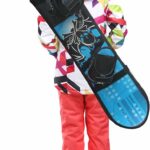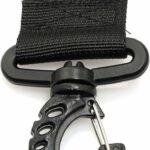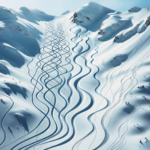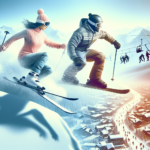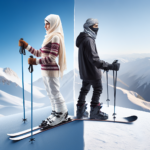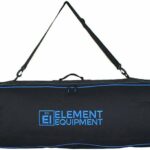In the relentless pursuit of winter sports and adrenaline-fueled excitement, you might find yourself amidst a classic debate, “What’s Harder Snowboarding Or Skiing?” Read on as we pull apart both sports, dissecting their nuances, requirements, and challenges to give you an essence of where the true difficulty lies. You might be contemplating whether to strap on a snowboard or buckle up the skis for your upcoming snowy adventure. Let’s begin this journey where we’ll examine techniques, equipment, fitness levels, and learning curves involved for both novice and experienced participants in these thrilling winter sports.
Learning Curve
Skiing and snowboarding are excellent winter sports that offer both exhilaration and challenge. If you’re new to either sport, you may wonder about the learning curve involved. Let’s start by discussing the initial difficulty in skiing.
Initial Difficulty in Skiing
Learning to ski might seem intimidating at first. You have to acclimate to the gear, the sliding sensation, and the posture required. Even so, most beginners find the initial phase of skiing relatively approachable. It doesn’t typically require too much time to learn the basic pizza wedge or snowplow move, which slows you down and keeps you stable.
Beginning Challenges of Snowboarding
Conversely, snowboarding often presents a steeper learning curve. You may struggle with falls and a few bruises in the initial phase as you learn how to manage the board’s edge control. Plus, moving with both feet strapped to the same board might seem unusual, and the balance required can be more challenging to master than in skiing.
Effect of Prior Experience
Of course, the learning curve can also be influenced by prior experience. If you have a background in surfing or skateboarding, the transition to snowboarding might feel more natural. Similarly, if you’re an ice skater or roller skater, you might find skiing more accessible.
Physical Demand
Both skiing and snowboarding are physically demanding, requiring a unique set of muscles and physical abilities.
Physical Endurance Requirement in Skiing
Skiing mainly engages the lower body, particularly the core and leg muscles. Endurance is vital, particularly during long downhill runs. Good cardiovascular condition, coupled with strong thighs and calves, can make your skiing experience more enjoyable.
Body Tension in Snowboarding
Snowboarding, on the other hand, also focuses on the core and legs, and involves a lot of twisting—requiring strong, flexible muscles throughout your body. Tension in the body is typically higher when snowboarding due to the sideways stance and the need to shift weight frequently for direction changes.
Physical Training Needed for Each
Regular cardiovascular workouts, core strengthening, and flexibility training can help you prepare physically for either skiing or snowboarding. However, each sport also benefits from specific strength training—leg exercises for skiers and full-body workouts for snowboarders.
Risk & Injury
Like all sports, skiing and snowboarding carry their own set of risks and potential injuries.
Common Injuries in Skiing
For skiers, common injuries typically involve the knees — from sprains to ACL or MCL tears. Additionally, skiers can experience wrist fractures, shoulder dislocations, and head injuries from falls or crashes.
Potential Dangers of Snowboarding
Snowboarders frequently encounter wrist and shoulder injuries due to falls, particularly during the learning stage. Moreover, because a snowboarder’s feet are strapped together, ankle injuries are common. Additionally, snowboarders should be aware of the risks involved with jumps and tricks.
Safety Measures
Regardless of the sport, the best way to minimize risk is to wear appropriately fitting gear, including helmets, wrist guards, and shoulder pads. Taking lessons from certified instructors can also reduce injury risks.
Balance & Coordination
Both sports require a significant amount of balance and coordination, but in slightly different ways.
Balancing Act in Skiing
In skiing, you find your balance mostly in a forward and backward motion with the ability to distribute your weight between two separate skis. This can feel more natural and intuitive, especially for beginners.
Coordination Skills in Snowboarding
Snowboarding requires a delicate balance between the heel edge and the toe edge. The balance is more side-to-side, which can be a little trickier to grasp. The ability to coordinate flexes and pivots from the ankles, knees, and hips is critical.
Improving Stability and Balance
Performing balance exercises off the mountain, like yoga or Pilates, can significantly improve your stability and coordination in skiing or snowboarding.
Speed & Control
When it comes down to speed and control, both skiing and snowboarding offer unique challenges.
Speed Control in Skiing
Skiing allows for easier speed control in the beginner phase due to the pizza wedge technique. However, as you progress onto steeper slopes, speed control requires much more advanced techniques such as parallel skiing, understanding edges, and using pole plants.
Handling Speed in Snowboarding
In contrast, controlling speed in snowboarding mainly depends on your edge control. This skill takes longer to master but eventually offers flexibility in controlling how fast or slow you go down the slopes.
Techniques for Better Control
In both sports, improving control comes down to practice, patience, and gradually pushing your comfort zone under supervision. Remember, speed should never compromise safety.
Terrain Adaptability
Different terrains offer varied challenges for skiing and snowboarding.
Skiing on Different Terrains
While skiing is usually more comfortable on groomed pistes, advanced skiers can navigate various terrains, including icy slopes and even deep powder with the right equipment and technique.
Snowboarding Terrain Challenges
Snowboarding allows for ease in deep snow and off-piste. Navigating flat sections and narrow trails can be more challenging as snowboards lack the free-heel mobility that skis offer.
Best Terrains for Beginners
For beginners in both sports, gently sloping, groomed runs are the safest to learn on. As you advance, you can slowly venture onto steeper slopes and varied terrain.
Technique Variation
Both skiing and snowboarding have a range of different techniques to learn and master.
Techniques Utilized in Skiing
In skiing, you’ll progress from the basic snowplow to parallel techniques. Eventually, you may graduate to carving turns, jumps, and even mogul skiing.
Snowboarding Style Varieties
In snowboarding, you’ll start with simple skidded turns before advancing to carved turns. As you progress, you might learn more complex tricks like grabs, spins, and flips.
Progressing Skill level
Regular practice, guidance from a professional instructor, and a focus on gradually increasing difficulty can help progress your skill level in either sport.
Equipment Familiarity
Understanding your equipment is key to success in both skiing and snowboarding.
Understanding Skiing Equipment
Skiing equipment includes skis, ski boots, bindings, poles, and a helmet. As a beginner, it’s essential to rent equipment from a trusted source where professionals can advise on the correct size and fit.
Getting used to Snowboarding Gear
Snowboarding equipment consists of a snowboard, boots, bindings, and a helmet. Familiarity with your snowboard, especially, can affect your control on the snow. Make sure it’s the right size and style for your skill level.
Maintenance and Preparation
Regardless of your sport of choice, keep your gear in excellent condition. Regular waxing and edging of your skis or board are an absolute must.
Community Perception
There’s a unique culture to both sports that influences your experience on the slopes.
Skiing as a Social Sport
Skiing, with its long history and broad appeal, often draws a diverse crowd. It can be a very sociable sport, with large groups navigating slopes together. This range of ski resorts also host après-ski social events that are part of the skiing experience.
The Snowboarding Subculture
Snowboarding carries a different but equally engaging subculture. This younger sport has roots in the rebellious spirit of surf and skate culture. Snowboarders might find themselves bonding over the latest tricks or best boarding spots.
Interaction among Skiers and Snowboarders
Despite contrasting cultures, skiers and snowboarders often coexist happily on the slopes. Mutual respect and shared love for the snow make for a positive skiing/boarding community.
Career Opportunities and Professional Competitions
The skies are the limit when it comes to professional opportunities in skiing and snowboarding.
Professional Path in Skiing
Talented skiers can aim for a career in professional skiing and compete in renowned competitions like the Winter Olympics or FIS World Cup. Other opportunities may lie in teaching skiing, working as a mountain guide, or even sports marketing and event management.
Career in Snowboarding
As for snowboarding, competitive aspirations could lead you to the X-Games, the Winter Olympics, or various snowboarding tours. Beyond professional competition, there are also opportunities in coaching, snowboard design, and even photography or filming in the action sports industry.
Major Competitions for Each Sport
Whether it’s the grace and speed of downhill skiing, the breathtaking jumps in snowboarding, or the combination of skills in freestyle events, both skiing and snowboarding offer thrilling competition prospects. Careers in these sports are anchored by major competitions that showcase talent and increase exposure.
In conclusion, both skiing and snowboarding offer various challenges and thrills. Whether you choose to ski, snowboard, or even both, remember to have fun, stay safe, and enjoy the journey of learning and mastering these exciting sports.
- What Snowboard Bindings Should I Get? - January 23, 2024
- What Size Screws For Snowboard Bindings? - January 23, 2024
- How To Snowmobile On Water? - January 23, 2024


